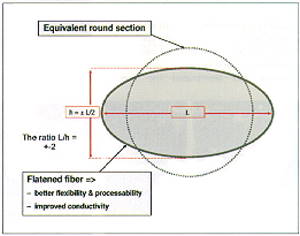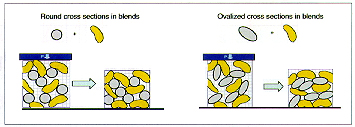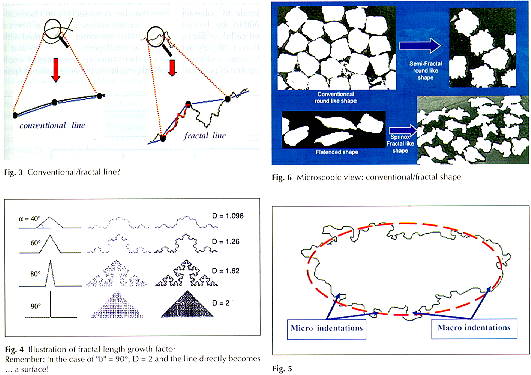
| ||
 |
Stainless steel fiber with a fractal type surface
Sprinox
Ugitech has been sold and therefore Swicofil stopped working with this supplier partner - please check out our new supplier Bekinox.
The fiber department of Ugitech has developed the new Sprinox stainless steel fiber, characterized by a special "fractal type shape" to maximize its specific surface and also to allow some unique properties for stainless steel fiber applications. One of the main interests of the "fractal type shape" is for filtration. The cross section of the Sprinox fiber has been engineered through association of two main characteristics: A semi-flattened shape, and its "fractal surface" type. General oval cross section Thanks to its flattened shape, the Sprinox fiber hat a preferential flexibility orientation. The flexibility of the fiber is therefore improved compared to other stainless steel fibers with round or round-like cross section. In fact, this leads to a much better behavior in difficult processes such as production of pure stainless steel non woven by example.
Another major advantage is that the fiber being wider, the number of contacts between each of these is much higher, specially for applications with low percentage of stainless steel such as antistatic fabrics or filtering applications. Therefore one can advantageously use 12 microns Sprinox fibers instead of conventional 8 micros fibers to avoid fiber breaks and small nep defects, in such products as 80/20 PET/stainless steel yarn. The flattened shape also contributes to the higher specific surface.
Fractal type surface of the Sprinox fiber What is a fractal line? A well known example of a fractal line is the Brittany coast. The more it is magnified, the more new indentations
appear. A good polygonal approximation of the length of a fractal line can be given by adding several reference segments. The measured length will depend of the measuring unit scale (km, m, mm, µm…). The smaller the measuring scale is, the longer the measured length will be. In fact the theoretical length of a fractal line tends to infinity as the measuring scale is reduced. The main difference between two fractal lines is in fact the speed at which it tends to infinite length as the measuring scale is reduced, or in other words the reference segment size. L/(L)D "D" being a fractal line characteristic number varying form 1 to 2. Fractal type shape of the Sprinox cross section In addition to the oval shape, the Sprinox fiber has been developed to optimize its specific surface.
Sprinox properties conventional fabrics For this reason, the surface of the Sprinox fiber is characterized by a very much higher specific surface against a conventional round like cross section. Therefore it optimizes the exchange between the filter media and the gas or liquid. The fractal type surface also allows, thanks to its micro cavities, a remarkable filtration efficiency to be obtained, although a rather coarse fiber (for example a 12 microns average equivalent diameter (DRCM) can be used. The relative positioning of theses fibers in a needle- punched or a calendared structure often gives a much better filtering efficiency than with conventional fibers. The use of very fine metallic fibers for micro filtration purposes can create a problematic generation of some loose metallic particles due to the weakness of microfibers. As the Sprinox fiber has a coarser cross section for the same efficiency, the structure itself is stronger and minimizes this effect. Last but not least, the fractal shape of the Sprinox fiber allows, in conventional textiles products, a lower density because of the bulk effect. A lot of air is kept between the fibers because of the macro-cavities acting as spacers. This characteristic plays an important role in hot glass molding process (improved density, heat release, softness, flexibility etc.).
Sintered and calendared applications In sintered applications, this fractal surface allows the use of generally lower pressure than conventional round like metallic fibers, giving a wider range of thickness and porosity, with a given process temperature. This wider range of filtration efficiency can be explained because, under pressure, it is the macro indentations in contact with other fibers that bends and sinter first, keeping most of the micro indentations unmodified, at least until higher temperature and pressure range. Although tests are currently being done, it is expected to be able to obtain, from the Sprinox fiber in 12 microns, micrometric porous structures allowing to enter the field of micro filtration. Therefore, in between the simple calendaring and the sintering process, the use of Sprinox fiber can lead to a wide range of specific properties. In the field of hot gas catalytic filtration, a team of industrial partners and research institutes are currently making an important research program for environmental issues (with the "ADEME"). The first results seem to be extremely promising. The micro indentations can also be used to store some specific chemicals or catalytic media. The very fine structure can provide a very good retention of these products once they have been trapped inside the indentations.
Conclusion Finally, the apparently "simple" geometrical modification of our Sprinox fiber, versus most of other stainless steel fibers present on the market, seems to be opening a very wide range of applications where technological limits could be pushed al little bit further away, in the interest of the industry, and also of our common environment!
| |
![]()
| Be notified of page updates |
wwwswicofilcom2015




